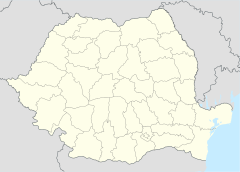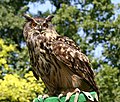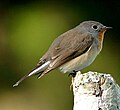Semenic-Cheile Carașului National Park
| Semenic-Cheile Carașului National Park | ||
|---|---|---|
| On the semenik | ||
|
|
||
| Location: | Caraș-Severin , Romania | |
| Next city: | Caraș-Severin County , Reșița , Caransebeș | |
| Surface: | 362 km² | |
| Founding: | 2000 | |
The Semenic-Cheile Carașului National Park (also Semenik-Karasch Gorge National Park , Romanian Parcul Național Semenic-Cheile Carașului ) extends over an area of 36,214 hectares in the Semenic Mountains and in the Anina Mountains , in the Caraș-Severin district , in southwest Romania .
description
The National Park Semenic Karaschklamm has a typical karst - and forest landscape and is characterized by the 300-year-old, single Book - primeval forest in Europe from.
The national park includes the nature reserves Karaschklamm ( Cheile Carașului ), the Karasch springs ( Izvoarele Carașului ), as well as stalactite and other caves.
The Karasch gorge is one of the longest, wildest and most beautiful on the national level, with a rich flora and fauna , with many caves , some of which are only accessible under water, with almost vertical limestone walls and the so-called "kettles" on the upper Karasch . On the right bank of the Karasch, above the Karasch gorge, lies the medieval Grat castle ruins (1230). One of the most beautiful caves in this zone, with diverse formations of stalactites and stalagmites , is the stalactite cave of Comarnic .
20 archaeological sites were discovered in the Semenik-Karaschklamm National Park .
history
In 1955 the Karasch Gorge ( Cheile Carașului ) was declared a nature reserve on an area of 800 hectares , in 1973 the forest reserve Neraquellen ( Rezervația Forestieră Izvoarele Nerei ) followed, in 1982 the Buhui-Mărghitas nature reserve, the Karasch springs ( Izvoarele Carașului ), followed Gârliştei Gorge ( Rezervația Cheile Gârliştei ) and the forest reserve Groposu ( Rezervația Forestieră Groposu ) were added, in 1991 the caves were declared a nature reserve and in 1993 the forest of Rezervația Bârzăvița received the status of nature reserve.
In 2000 the Semenik-Karasch Gorge National Park was established by law (Legea nr. 5/2000) as follows:
- The Karasch Gorge Nature Reserve ( Rezervația Cheile Carașului ) - 2988.67 hectares
- The Gârliştei Gorge Nature Reserve ( Rezervația Cheile Gârliştei ) - 582.18 hectares
- Buhui-Mărghitaș Nature Reserve ( Rezervația Buhui- Mărghitaș ) - 217.64 hectares
- The Karash Springs Nature Reserve ( Rezervația Izvoarele Carașului ) - 1,384.06 hectares
- The Neraquellen Nature Reserve ( Rezervația Izvoarele Nerei ) - 5,012.32 hectares
- The Bârzavița Forest Reserve ( Rezervația Bârzavița )
- Groposu Forest Reserve ( Rezervaţia Groposu )
- Buhui Cave Nature Reserve ( Rezervația Peştera Buhui ) - 217.64 hectares
- The Comarnic Cave Nature Reserve ( Rezervația Peştera Comarnic ) - 26.9 hectares
- The Popovăț Cave Nature Reserve ( Rezervația Peştera Popovăț ) - 4.5 hectares
About 40% of the area of the national park are nature reserves: Buhui, Mărghitaș, Karasch gorge and the Karasch springs, the Nera springs, the Garliștea gorge. Groposu and Bârzavița are forest reserves.
flora
Over 1200 plant species are under nature protection, such as:
- the oriental hornbeam ( Carpinus orientalis )
- the Blazing butcher's broom ( Ruscus aculeatus )
- the small-flowered cinquefoil ( Potentilla micrantha )
- the yellow flax ( Linum uninerve )
- the gold crocus ( Crocus flavus )
fauna
The Semenik Karasch Gorge National Park is home to over 690 animal species, including 29 invertebrates unique to this region and 45 other rare species. These give the park a special meaning. The invertebrates in the Karst are represented by rare species of centipedes (Chilopoda):
- Chilopoda ( Lithobius dacius )
- Chilopoda Bulgarosoma ocellatum
- Coleoptera ( Duvalis milleri )
Different species of long-extinct snails survived the Little Ice Age here:
The world of fish is represented by the following rare species:
- Rhone nerd ( Zingel asper )
- Brown trout ( Salmo trutta fario )
- Tench ( Tinca tinca )
- Barbus ( Barbus meridionalis petenyi )
- Barbus ( barbus barbus )
- Nose ( Chondrostoma nasus )
Amphibians are represented by:
- Mountain Newt ( Triturus alpestris )
- Northern crested newt ( Triturus cristatus )
- Pond newt ( Triturus vulgaris )
- Fire salamander ( Salamandra salamandra )
- Yellow-bellied toad ( Bombina variegata )
- European tree frog ( Hyla arborea )
- Common Frog ( Rana temporaria )
Among the reptiles we should mention:
- Eastern green lizard ( Lacerta viridis )
- Sand lizard ( Lacerta agilis )
- Forest lizard ( Lacerta vivipara )
- Wall lizard ( Podarcis muralis )
- European horned viper ( Vipera ammodytes )
- Slow worm ( Anguis fragilis )
- Smooth snake ( Coronella austriaca )
- Grass snake ( Natrix natrix )
- Dice snake ( Natrix tessellata )
- Aesculapian snake ( Elaphe longissima )
The bird world is represented by species that nest here, but migratory birds can also be found:
- Black stork ( Ciconia nigra )
- Lesser Spotted Eagle ( Aquila pomarina )
- Schlangenadler ( Circaetus gallicus )
- Tree falcon ( Falco subbuteo )
- Eagle owl ( Bubo bubo )
- White-backed woodpecker ( Dendrocopos leucotos )
- Miniature Flycatcher ( Ficedula parva )
- Whinchat ( Saxicola rubetra )
- Siskin ( Carduelis spinus )
The mammals are represented by the following species:
- Brown bear ( Ursus arctos )
- Wolf ( Canis lupus )
- Eurasian lynx ( Lynx lynx )
- Wild cat ( Felis silvestris )
- Red fox ( Vulpes vulpes )
- Wild boar ( Sus scrofa )
- Red deer ( Cervus elaphus )
- Roe deer ( Capreolus capreolus )
- European marten ( Martes martes )
- Red squirrel ( Sciurus vulgaris )
The caves are home to numerous species of bats . A total of 16 species were identified:
- Greater horseshoe bat ( Rhinolophus ferrum-equinum )
- Meheley horseshoe bat ( Rhinolophus mehelyi )
- Mediterranean horseshoe bat ( Rhinolophus euryale )
- Blasius horseshoe bat ( Rhinolophus blasii )
- Ciliate bat ( Myotis emarginatus )
See also
Web links
- rumaenien-tourismus.de (PDF; 2.1 MB), Nature Tourism Romania. Discover the Carpathian Garden.
- dfbb.ro , The Karasch Gorge and the Comarnic Cave
- pnscc.ro , official website of the Semenic-Cheile Carașului National Park (Romanian)



























